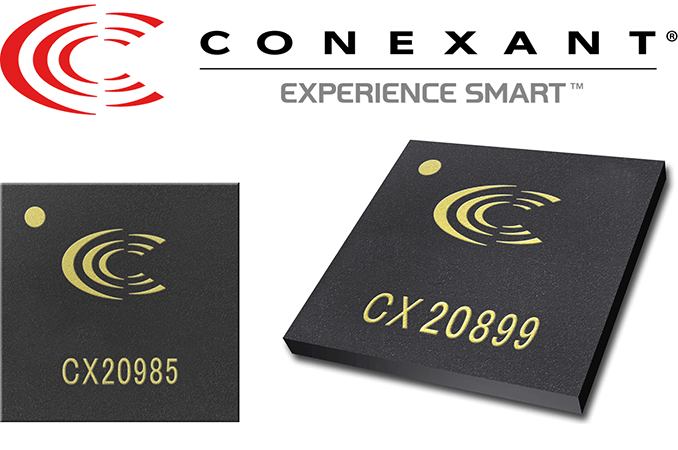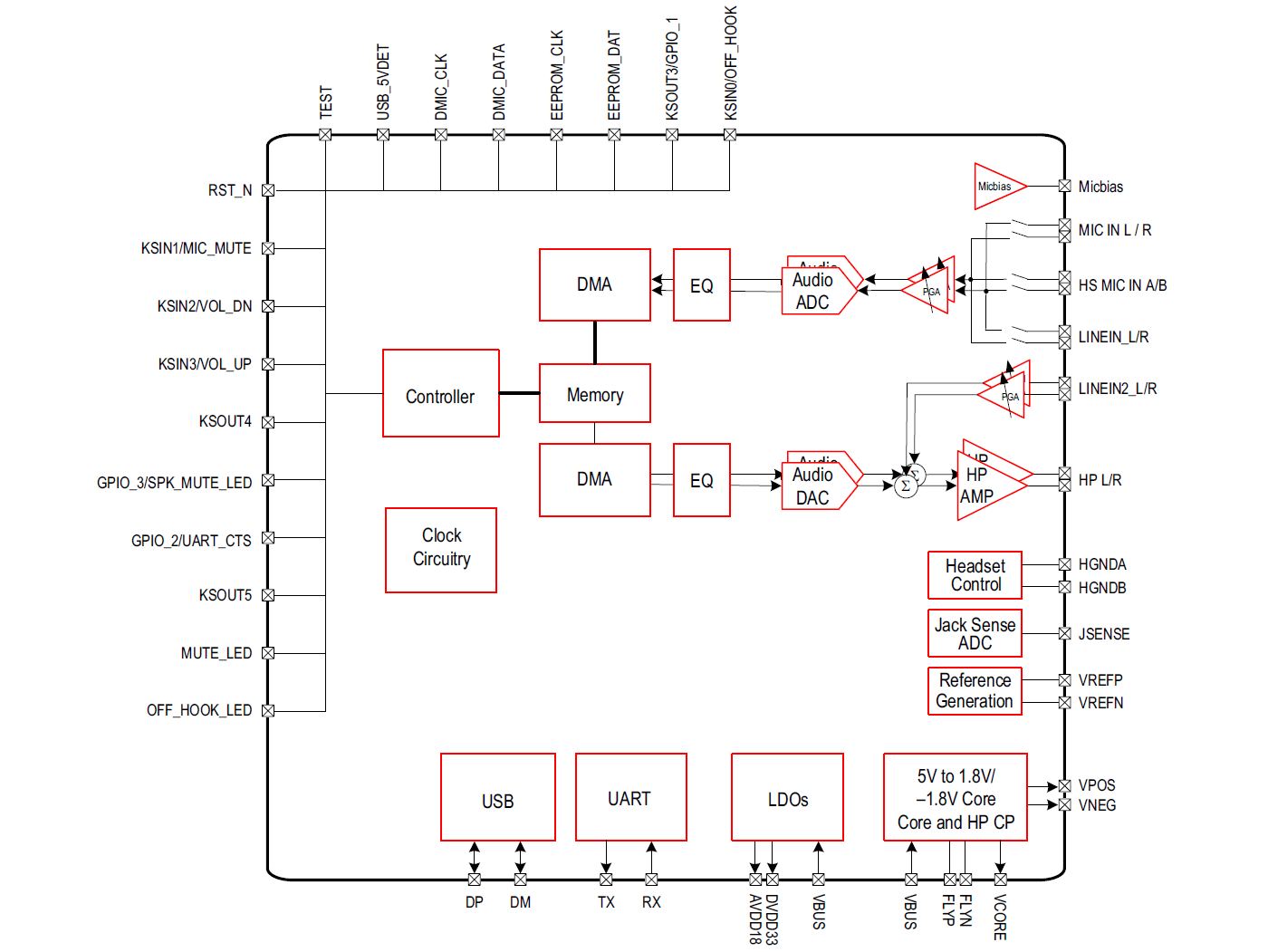Conexant Introduces USB-C Digital Audio Compliant Chips
by Anton Shilov on May 11, 2016 8:30 AM EST- Posted in
- Mobile
- Intel
- Conexant
- USB-C
- USB-C Digital Audio

Just recently, Intel announced a proposal for its part in the USB-C Digital Audio specification, which is expected to be finalized in the coming weeks. Judging by our email, the first chips compliant with the new spec were announced on Tuesday by Conexant, and we asked for more information. These chips are about to hit mass production in mid Q2, therefore the first devices with USB-C Digital Audio might be expected to hit the market later this year.
Conexant introduced two new AudioSmart CODECs which are designed specifically for smartphone headsets and docking stations that use USB Type-C connection. We are told that the CX20985 and the CX20899 are to be compliant with the yet-to-be-released USB-C Digital Audio specification, and they support enterprise requirements for Skype for Business as well as meet the Android Wired Audio Headset specification. Both chips support USB 2.0 bandwidth of up to 480 Mbps, which should be enough for audio as well as additional functionality. Finally, the parts support four-conductor CTIA and OMTP headsets with up to eight buttons and can auto-detect and auto-switch between them. Since these are two very different chips with dissimilar capabilities, let’s talk about them separately.
The Conexant CX20985 is specifically designed for headsets, but it could be used for other audio applications too. The chip integrates a stereo 24-bit DAC and stereo ADC for music and voice communication applications and supports sampling rates of up to 48 kHz. Besides this, the CX20985 has a built-in capless headphone driver that eliminates the cost and space of AC coupling capacitors. In addition, the chip sports a five-band parametric equalizer for playback, a two-band equalizer for recording, and adjustable microphone boost circuitry. The CX20985 is promoted with minimal power consumption: the specification sheets list the nominal idle current as 22.6 mA with a voltage between 4.35 and 5.25 V. The CX20985 is set to hit mass production in July and is projected to be available in 6×6 mm 50-pin QFN package.
While the CX20985 should be fine for mainstream headsets, Conexant does not expect it to be used for higher-end digital headsets. The chip does not support sampling rates higher than 48 kHz, something that their Hi-Fi audio partners and customers expect. By comparison, the CX20899 has improved DAC and power supply circuitries, which will effect the quality of analog audio.
The Conexant CX20899 is optimized for larger devices, such as docking stations, yet it could be used to build higher-end headsets as well. This chip is considerably more advanced than the CX20985: it features a fully-fledged digital signal processor (DSP), supports sampling rates up to 96 kHz (both on DAC and ADC) as well as stereo playback path with differential line-out or capless headphone driver. The DSP fully supports functions as acoustic echo canceling, noise reduction, a programmable equalizer, digital room correction, microphone AGC (automatic gain control), volume control, and a microphone boost. The CX20899 also supports PCM/I2S and S/PDIF digital audio interfaces which should help to build docking stations for mobile devices and subsequently connections to Hi-Fi audio equipment via USB-C. The power consumption of the CP20899 is listed as a nominal idle current is 1.8 mA with a voltage is between 4.35 and 5.25 V. The chip uses a 76-pin QFN package and is currently in mass production.
Conexant was one of the early adopters of the USB Audio technologies many years ago and it is not surprising that it is also among the first to support the USB-C Digital Audio technology. Going forward, Conexant intends to introduce more sophisticated USB-C Digital Audio-compliant chips, which will enable health-monitoring headsets as well, following the wearable/health trend in the market.
Conexant does not reveal pricing of its chips for digital headsets, but typically such chips are not very expensive. For example, Conexant’s previous-generation USB Audio-compliant semiconductors for headsets cost around $1 per unit.
Source: Conexant












31 Comments
View All Comments
SunnyNW - Wednesday, May 11, 2016 - link
And what about the mechanical integrity of the type-C connector? I feel like the 3.5mm audio jack might be more durable. I don't think the designers of type-C accounted for people having it plugged in while in their pockets, etc.ZeDestructor - Wednesday, May 11, 2016 - link
Neither did the 3.5mm guys, for the most part. Really, if you think about it, it's really easy to break a 3.5mm jack (I've broken my share over the years), arguably easier than USB-C (the shorter connector length means that it should in theory be easier to unplug the whole way out when stressed), but that remains to be seen.On the sucject of cost, you can flip that argument right round: one the vendors ditch 3.5mm jack, there's a lot of saved space and components - both in terms of the physical DAC and being able to slice the entire analog section clean off, including engineering signal isolation and such.
Overall, I think it'll be more positive than negative in the long run, but we shall see.
As for iteration on the port itself, I don't think we'll see anything there for a long time: USB-C already runs off a 4-lane setup, which is the norm for various high-bandwidth, external connectors right now. The PHYs and devices will upgrade, but I don't think the connector itself will for a long time. Oh and an example of longevity, about the only connectors that have been around for a comparable amount of time to USB-A in computing would be IEC power for PSUs and chargers, 15-pin D-SUB video, 3.5mm audio jacks and 8P8C ethernet for the majority, with RS-232 still used in certain niches (but increasingly replaced by embedded UART->USB serial bridges and various networked protocols like telnet and SSH). Just about everything else has been replaced over the years by something better, USB for the most part.
Impulses - Wednesday, May 11, 2016 - link
Can't slice the analog section out unless you're gonna build laptops and phones without speakers...PlasticMouse - Friday, May 20, 2016 - link
The USB-C Connector was designed as a mobile connector from its conception; it's significantly mechanically stronger than the USB Micro-B connector, rated for 10,000 insertion/removal cycles which greatly exceeds most 3.5mm jacks, and in an extreme case, the USB-C plug is designed to fail before the receptacle.phoenix_rizzen - Wednesday, May 11, 2016 - link
USB Type-C connections and the USB Audio standard support analog audio on separate pins, so it'll be very easy to create an adapter to convert between 3.5 mm audio jacks and USB connectors. Your old headphones will still work on new devices, and your new USB headphones will work on your old devices.You don't need two separate USB Type-C plugs in order to support charging and audio-out. You just need a USB splitter/hub. Apple makes several that allow power passthrough and digital connections. Pretty sure there'll be all kinds of inexpensive ones in various formfactors soon enough. There will probably even be phone-specific ones that just slip onto the bottom of the phone and provide two USB Type-C ports; or they'll be built into cases like extra batteries are. It's not an either-or situation.
Impulses - Wednesday, May 11, 2016 - link
AFAIK Intel said the standard could support analog out on spare pins, I dunno that it's ultimately gonna be part of the spec or that OEM will support it... I'd guess chips like these definitely would despite the touted Type C support tho, because the typical Type C headset would move most of the functionality of these chips into the headset itself...It's getting pretty confusing tbh, and that's film an enthusiast's pov who understands the technical aspects, this has a very high potential for flopping if the mass market can't figure it out (or simply shrugs and opts for Bluetooth). I doubt there's a lot of phone OEM clamoring for discrete audio IC when the main SoC can usually handle it too...
8steve8 - Wednesday, May 11, 2016 - link
1) it does not add complexity.. it's just moving the D/A/Amp closer to the speakers, which is always welcome... especially removing connector transmitting analog is a huge benefit.2) anything new has a price premium, but eventually the phone will get cheaper as it doesn't need a D/A/Amp, and the speaker/headphones will get a bit more pricey.
3)ok
4)ok
5), good question, will there be usb-c passthrough's on the charger somehow?
I've never listened to music on my phone while charging, do you think that's a significant application?
I do listen to music from my phone while charging, via chromecast then to speakers with a digital input.
JoeyJoJo123 - Wednesday, May 11, 2016 - link
upboatDaniel Egger - Wednesday, May 11, 2016 - link
Odd, the higher end version has a magnitude less idle current?nightbringer57 - Wednesday, May 11, 2016 - link
Maybe the lower end version is an earlier design, with all the important features, but no refinement (e.g. fine-tuned power gating and stuff like that)? This may be related to the higher-end regulators included in it as well.